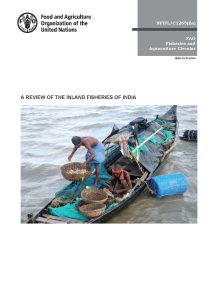India has abundant water resources including rivers, canals, ponds, lakes, reservoirs, upland lakes, and floodplain wetlands covering over 5.8 percent of the country. These environments harbour a rich fish fauna of 1 035 species that constitutes the basis for the inland fisheries sector, which annually produces 2 144 452 tonnes of fish – if enhanced and culture-based fisheries are included – corresponding to 21 percent of total fish production. Rivers like the Ganga, Brahmaputra, and Barak, alongside floodplain wetlands, play crucial roles, especially in the east and northeast. Lakes are abundant in upland areas. Reservoirs cover over 1 percent of India’s land and hold untapped potential for fisheries development. Traditionally, fishing in inland water bodies has been a small-scale or subsistence activity. Fishing practices, crafts and gear used in inland fisheries are still traditional.
 Cooperative societies are present in reservoirs and wetlands giving fishers better bargaining power with traders and better prices for the fish. Inland fisheries are imperative for poverty alleviation, food security, gender empowerment, cultural services, ecosystem function, and biodiversity, and are important for achieving the Sustainable Development Goals. Important threats to inland fisheries include water scarcity, habitat loss, pollution, climate change and invasive species. However, several major river conservation programmes have been initiated.The collection of inland fishery catch statistics remains weak and production appears to be significantly under-reported in many states. A simplified method for defining water bodies and estimating catch is proposed and all States have been advised to follow the same definition for water bodies.
Cooperative societies are present in reservoirs and wetlands giving fishers better bargaining power with traders and better prices for the fish. Inland fisheries are imperative for poverty alleviation, food security, gender empowerment, cultural services, ecosystem function, and biodiversity, and are important for achieving the Sustainable Development Goals. Important threats to inland fisheries include water scarcity, habitat loss, pollution, climate change and invasive species. However, several major river conservation programmes have been initiated.The collection of inland fishery catch statistics remains weak and production appears to be significantly under-reported in many states. A simplified method for defining water bodies and estimating catch is proposed and all States have been advised to follow the same definition for water bodies.